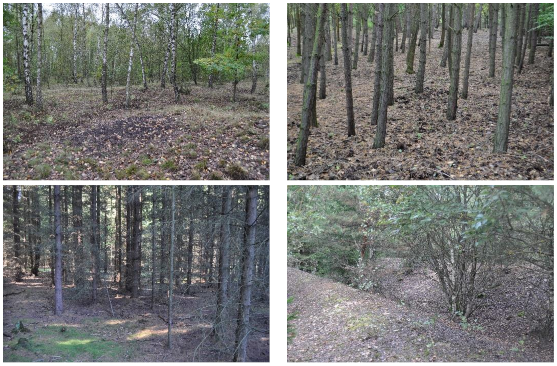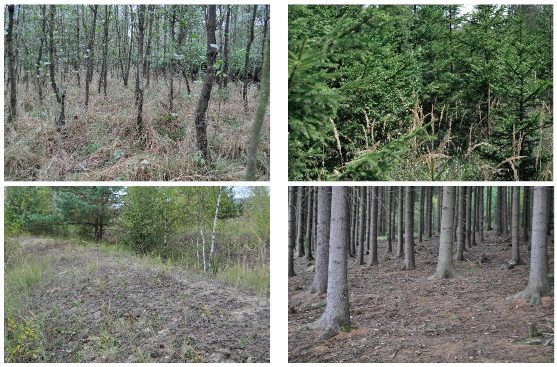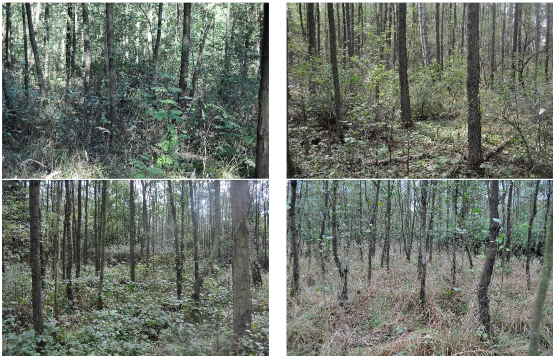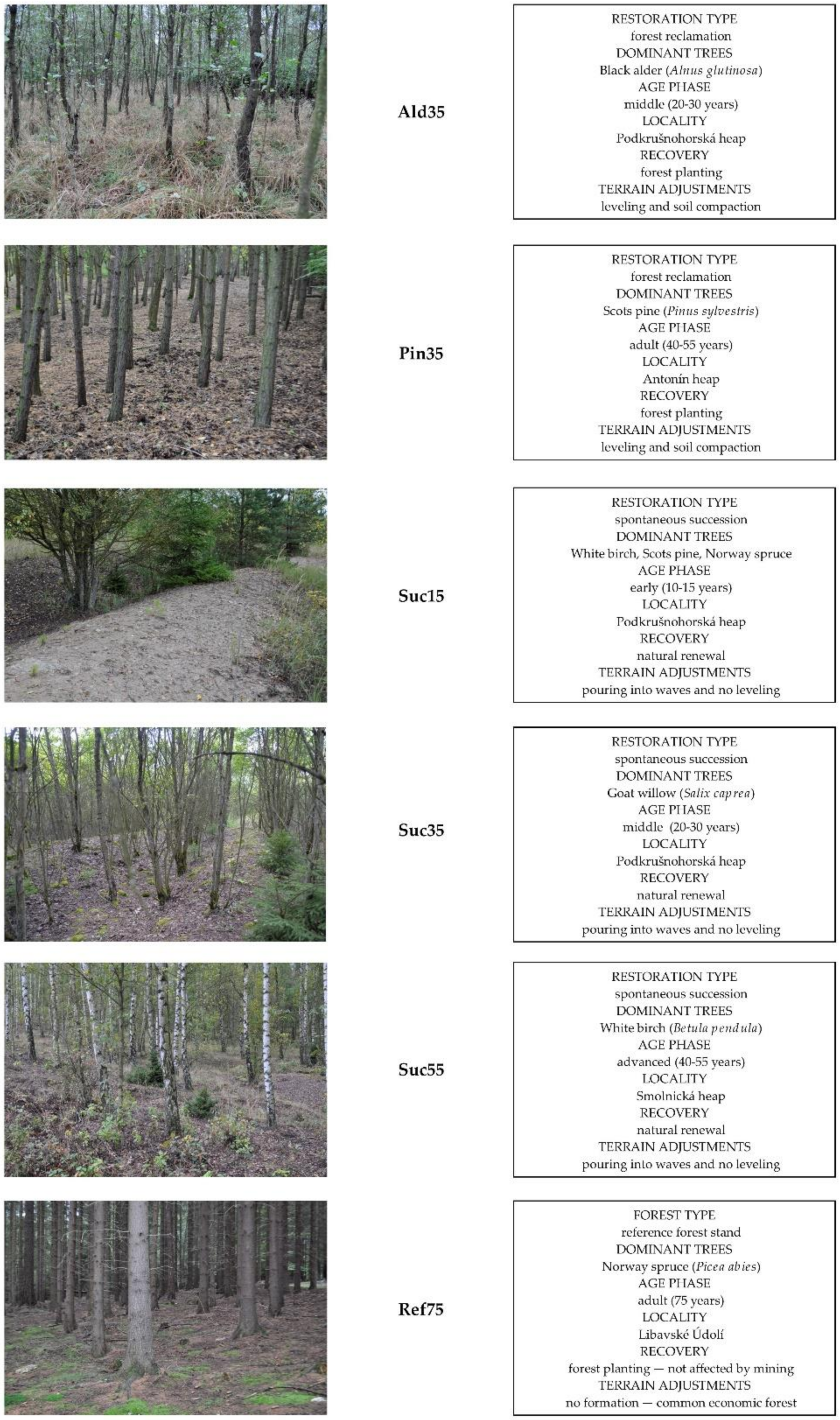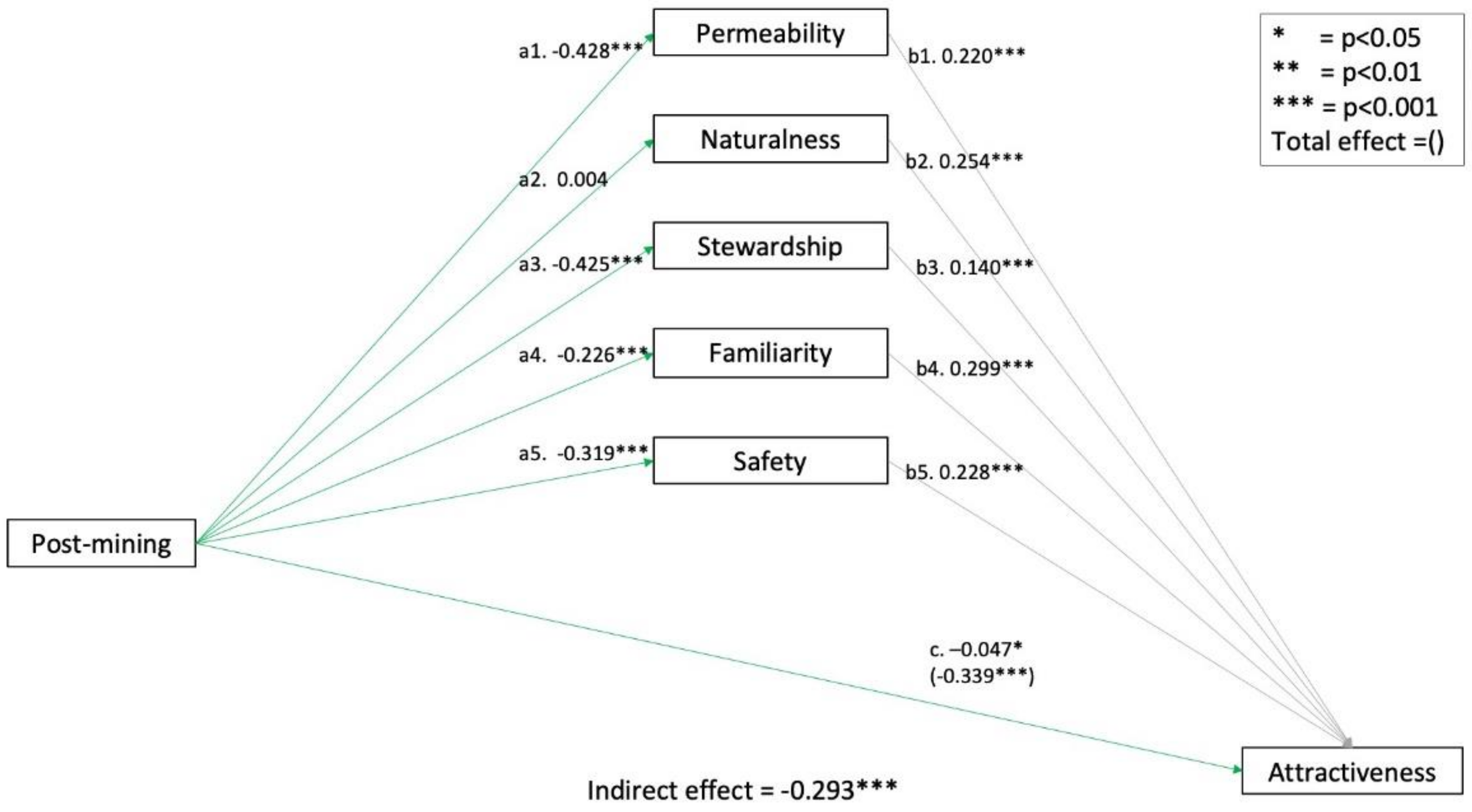1. Introduction
Temperate forests are among the most aesthetically valued ecosystems and environments for recreation. In Han’s study [
1] comparing the attractiveness of six different biomes (coniferous forest, deciduous forest, desert, grassland, tropical forest, and tundra), forested biomes were perceived as very attractive, with coniferous and deciduous forests ranking much higher than grassland or desert. Quite a lot has been discovered about how its observable characteristics such as observed permeability, structural diversity, or perceived naturalness affect its attractiveness [
2,
3,
4].
Nevertheless, in several forests planted and managed by people, it seems that care for the visual face of the forest has not yet become common practice. Typical examples are restored forests in areas that had been affected by previous open-cast coal mining activity. Understandably, other observable criteria and ecosystem functions such as geomorphological, hydric, and ecological balance [
5] have priority, especially in the initial phase of a spoil heap’s restoration. However, over time and at the moment of opening these forests to the public (for recreation), their visual appearance becomes of crucial importance. As Tyrväinen et al. [
6] note, the quality of landscape and environment is one of the important elements for natural tourism. In the case of this study, natural tourism was centered around longer travel distances. According to these authors, the environmental preferences of people should be considered in forest planning and management. This is especially true in regions aiming at expanding their tourism carrying capacities [
6], which is the case of many regions in the Czech Republic where coal mining has been terminated.
To provide a guideline for practitioners who are in charge of the management of human-made forests, we investigate how various observable characteristics of forests re/planted in post-mining areas affect their attractiveness. In this study, we focus on forests that were either replanted with a dominant tree species or spontaneously arose in the process of uncontrolled succession and consider three different growth stages of corresponding age classes (early stage between 10 and 15 years, middle stage between 15 and 35 years, and young stage between 35 and 55 years). Our research elaborates on previous knowledge about environmental preferences and extends its validity to the young stages of human-made and entirely natural outdoor environments.
Our findings are particularly relevant in the central European region (Czech Republic, Poland, East Germany) where large-scale open-cast mines and the spoil heaps in their vicinity were abundant and where re-/forestation has been one of the typical reclamation practices. According to Alves Dias et al. [
7], there are 14 active open-cast coal mines extracting brown coal and lignite deposits in the Czech Republic (1 mine in the Sokolov basin and four mines in the North Bohemian basin), Poland (1 mine in the Bełchatów basin, one mine in the Turoszów basin and two mines in the Konin–Adamów basin), and East Germany (4 mines in the Lusatian area and three mines in the Central German area). In addition to the afforestation of post-mining areas for forestry use, extensive areas of degraded mining land are often transformed into agricultural land, artificial lakes, natural landscapes, and for recreation purposes, e.g., golf course, arboretum, bike park, water-based activities. We believe that our findings also relate to the reclamation of other human-made nature-like ecosystems, such as areas close to large road constructions.
2. Environmental Preferences and Post-Mining Forests
People often spend their leisure time in forested areas close to cities and towns and engage in recreational activities ranging from simply walking alone, with a family or dogs, outdoor exercising to hunting. However, not all forest areas are liked [
8,
9] and numerous observable characteristics have been identified to influence forest attractiveness [
10]. Ode et al. [
10] employed existing theoretical concepts of a landscape’s visual character to create a nomenclature of characteristics and their measurable indicators. They identified coherence, perceived naturalness, disturbance, stewardship, complexity, imageability, historicity, ephemera, and visual scale as basic observable characteristics affecting landscape aesthetics [
10]. Several visual indicators derived from these theory-based concepts have been investigated in empirical research [
5,
9,
11,
12,
13,
14]. Out of the structural attributes on the level of forest stands, the following affect the preference of visitors: size, volume, and structure of trees and undergrowth, species composition, and signs of forest management. People prefer tall/mature trees to short/young-stage trees, medium-level of the undergrowth, low level of shrubs, and absence of signs of soil preparation, e.g., [
5,
12,
13,
15,
16,
17,
18]. A middle to higher variation in the size of trees is appreciated [
12] together with some variation in tree spacing; trees situated in the foreground are appreciated rather than when placed in the background or being spread [
14]. A medium-level tree density and ground vegetation are preferred [
12,
14]. A higher number of tree species and natural-looking features of the forest have positive impacts on peoples’ preferences [
12,
13]. On the contrary, the size of clear-cuts, residues from both harvesting and thinning, and dead trees have a negative impact on preferences [
12,
13,
14,
16,
18,
19,
20].
Even if the structural attributes of forests relatively consistently affect the preference in different countries, socio-demographic groups, and groups of people with different interests [
15,
17,
18,
19], the degree of these relations varies between different landscape settings, cultural contexts, and socio-demographic groups [
12,
21,
22,
23]. For example, the volume of large trees increases the preference for the forest more in men than in women [
22]. Older women in Norway preferred grassland and heathland (compared to forests) more than other population groups [
24]. Ribe [
25] shows that people favoring resource production have lower standards of visual quality/scenic beauty than people favoring resource protection. Mean tree height affects the preference more in a group of forest owners than in a group of non-owners [
22]. Different explanations exist for heterogeneity in preferences towards the same forest structures: the effect of familiarity on the environmental preference [
11,
24]; different underlying values besides the aesthetics such as ecological values, attitudes, and interests [
25,
26,
27], background knowledge, and available information [
16,
19,
25]. In effect, different factors of preference may be identified in studies conducted on different types of samples, such as experts in forestry, interested groups, and landowners, e.g., [
14,
15,
16,
25] or the general public, e.g., [
16] and visitors, e.g., [
13].
The visual characteristics evaluated in the current study represent general concepts of scenic beauty in a way they are perceived and interpreted by individuals rather than well-measurable physical attributes of the setting; see [
12,
15]. Hence, the general concepts may capture a mutual effect of several structural attributes such as the size of trees, extent of tree cover within the stand, and density of ground vegetation, the effect of which has been well-documented in the above-referred literature, e.g., [
12,
14,
16,
18].
In this research, we focused only on five general observable characteristics, namely, permeability, stewardship, perceived naturalness, safety, and familiarity. These features of forest appearance were selected as potentially relevant to post-mining forests, either as being typical for restored forests (such as a low level of permeability/prospect and stewardship) or being associated with mining activity and the subsequent restoration management (perceived naturalness, safety, and familiarity). The five features of the forests selected in the current study were most frequently observed and spontaneously evaluated by respondents in a small-scale qualitative pilot study that preceded the survey (
N = 18). The additional features identified in the literature [
10] were either not verbalized (such as coherence or imageability) or not relevant (e.g., ephemera) for the current study. A low level of permeability has been previously found to be associated with low restorativeness [
9], which in turn decreases the environmental preference [
28]. Gatersleben and Andrews [
9] found that natural environments with a higher level of prospect (clear field of vision) and lower level of refuge are more restorative than environments with a lower prospect and high refuge. The positive impact of an open view has been corroborated by yet other authors, e.g., [
12,
13,
24]. Their findings imply that less permeable and potentially dangerous environments demand more attention, lead to a lower restorative potential, and may be, therefore, less preferred.
Additionally, stewardship in terms of visible signs of human care and land use affects peoples’ preferences [
29]. However, the direction of the effect of stewardship on preference is not clear. While people prefer forests close to the natural state and with a low level of stewardship, they also like the results of forest management which improve the aesthetic quality of a forest allowing for a clearer view [
15] such as the removal of deadwood and cuttings.
For recreation, more natural environments that appear more natural to the observers are generally preferred, even if the perceived naturalness may not correspond to the ecological natural state as a result of the process of uncontrolled succession. In addition, perceived closeness to the natural state may be based on the state of the ecosystem and landscape management [
30]. For instance, in protected areas, careful management may be often conducted to increase ecological naturalness. According to Hoyle et al. [
11], there is a positive association between the perceived naturalness and planting structure. In their study, they discovered that landscapes with intermediate levels of management were perceived as more natural than strongly natural landscapes in terms of ecological naturalness. Their research uncovered a significant but weak relationship between ecological naturalness and aesthetic perception. Landscapes with moderate to higher levels of succession were preferred more [
11]. Importantly, for this research, perceived naturalness is influenced by culture and history. Naturalness is perceived through the lens of the traditional local landscape, land use, and cultural patterns [
10], which, in the Czech Republic, much of the landscape is shaped by commercial timber forests with a spruce monoculture. Which is one of the reasons why the spruce even-aged forest is considered as a reference forest in this study. Naturalness, unless otherwise indicated, is further understood as a perceived naturalness that appears natural to observers.
Some natural environments are not perceived to be safe and invoke a sense of fear. In their research about the attractiveness of urban green spaces, Lis et al. [
31] discovered that perceived danger is affected by perceived path use and concealment. The number of shrubs has a clear effect on perceived danger because large shrubs could easily hide dangerous people or animals. Desolate landscapes with signs of low use often lead to a sense of danger. Chiang et al. [
32] discovered that a high level of visibility is associated with perceived safety and that an increase in threat combined with an increase in exploration yielded an increase in preferences. Chiang et al. [
32] uses this example to argue that in some cases, negative feelings for the environment may later transform into positive feelings, such as fear turning into a positive emotional response. In their research about forested urban areas, Sonti et al. [
33] uncovered some reasons why people may perceive forest areas as dangerous. One of the main reasons for not visiting urban forests is fear for safety, where women may fear for their safety and men are worried about the safety of women. People are afraid of drug addicts and drunk people in the area. Another source of worry may be natural dangers, such as becoming lost in the forest or running into rats or insects. Some of Sonti’s et al. [
33] interviewees voiced a clear dislike of the perceived dirtiness of natural areas.
The last characteristic which affects the attractiveness of outdoor environments and which may be relevant for post-mining forests is familiarity [
29,
34]. Familiarity with an environment has been shown to affect environmental preference in the same direction [
29,
34,
35,
36], but also evidence to the opposite exists. Participants in studies by Svobodova et al. [
5] and by Arnberger and Eder [
29] preferred other environments than those in which they grew up. Of note is that Svobodova et al. [
5] investigated the environmental preferences of people living in post-mining regions where familiarity relates to a restored forest, as in this research.
5. Results
5.1. The Effect of Observed Characteristics on the Attractiveness of Post-Mining Forests
An ordinal logistic model corroborated the original expectation that post-mining forests are much less attractive than the reference commercial spruce timber forest, B = −1.53, OR = 0.21, 95% CI (−1.68, −1.39), z = −21.39, p < 0.001; B denotes the unstandardized regression coefficient and OR denotes the odds ratio in the ordered logit model, CI are 95% confidence intervals for B, z is the test statistic for the test of B and p is p-value for z-test. Model one revealed that post-mining forests were perceived as less attractive than the reference forest and that the lower attractiveness was affected by the observed characteristics; the indirect effect of post-mining was negative (β = −0.293) and statistically significant (p < 0.001); β denotes standardized regression coefficients of a fitted structural equation model and p corresponds to p-values of z-test. After accounting for the indirect effect of the observed characteristics, the effect of the post-mining forest significantly decreased (total effect, β = −0.339, p < 0.001 and the direct effect, β = −0.047, p < 0.05).
From the individual observed characteristics,
permeability had the strongest indirect effect on
attractiveness (
β = −0.094,
p < 0.001), followed by
safety (
β = −0.073,
p < 0.001), and
familiarity (
β = −0.068,
p < 0.001). The indirect effect of
naturalness was not statistically significant. Regression coefficients on the left-hand side of model one showed that post-mining forests differed from commercial timber forests in particular in terms of low levels of
permeability (
β = −0.428,
p < 0.001),
stewardship (
β = −0.425,
p < 0.001), and
safety (
β = −0.319,
p < 0.001). Post-mining forests were not perceived as being different in
naturalness; the effect of post-mining forests on
naturalness was not statistically significant. Post-mining forests were less familiar to people than commercial timber forests (see
Figure 2 for details). The effects of all the observed characteristics on the
attractiveness of the forest for recreation were positive and statistically significant.
5.2. The Effect of Observed Characteristics on the Attractiveness of Different Types of Restored Forests
The effect of different reclamation practices on the visual character of the forests and their attractiveness at the age of 35 years were tested in model 2. The replanted alder forest (Ald35) and spontaneous successional forest (Suc35) were compared to the replanted pine forest (Pin35) that was kept as the reference category in the model. Model two revealed that observed characteristics largely accounted for the differing attractiveness of forests created through different restoration practices. However, no systematic difference was visible in the age of 35 years between re-planted and spontaneously growing successional forests. Both total effects of Ald35 vs. Pin35 (β = −0.474, p < 0.001) and Suc35 vs. Pin35 were negative, but the latter was much smaller (β = −0.071, p < 0.001). It showed that the pine forest was the most attractive, followed by the successional, and then the alder forest. Additionally, both indirect effects, which captured the mediation by observed characteristics, were negative and statistically significant (for Ald35, β = −0.271, p < 0.001, for Suc35, β = −0.075, p < 0.001). The larger negative effect of Ald35 than of Suc35 indicated that this type of restoration yielded significantly visually inferior forests than spontaneous succession. This finding was further corroborated by the large negative effects of Ald35 on the observed characteristics, namely, on permeability (β = −0.646, p < 0.001), stewardship (β = −0.561, p < 0.001), safety (β = −0.445, p < 0.001), and familiarity (β = −0.183, p < 0.001). From the point of view of naturalness, Ald35 was, on the contrary, perceived positively (β = 0.126, p < 0.001).
The spontaneous successional forest was inferior to the pine reclaimed forest in all observed characteristics except for naturalness, but the effects were smaller than those of
Ald35; specifically for
familiarity (
β = −0.137,
p < 0.001),
permeability (
β = −0.132,
p < 0.001), and
safety (
β = −0.060,
p < 0.01). Interestingly, the successional forest was perceived as being less natural than both reclaimed forests
Pin35 (
β = −0.062,
p < 0.05) and
Ald35—admittedly, due to visible wave-like terrain unevenness created by the dumping of overburden material typical for this growth stage. Concerning
stewardship,
Suc35 did not significantly differ from
Pin35 (
β = −0.005,
p > 0.05). See
Figure 3 for more details.
5.3. The Effect of Observed Characteristics on the Attractiveness of Different Growth Stages of Successional Forest
The effect of age, at the growth stages of 15, 35, and 55 years, of the spontaneous successional forest on attractiveness and mediation of the effect by observed characteristics was tested in model 3. The middle-age category Suc35 was held as the reference category. The total negative effect of Suc15 (β = −0.152, p < 0.001) and the total positive effect of Suc55 (β = 0.134, p < 0.001) revealed that the attractiveness of the spontaneous successional forest increased with time. Both positive and statistically significant indirect effects indicated that the improving visual character of the forest mediated the effect of age on the attractiveness of the successional forest (for Suc55, β = 0.187, p < 0.001, for Suc15, β = −0.062, p < 0.05). After accounting for the mediators, both direct effects decreased significantly and the direct effect of Suc55 was no longer statistically significant (β = −0.052, p > 0.05).
A larger indirect effect of
Suc55 than of
Suc15 together with generally larger effects of the age on observed characteristics for
Suc55 than for
Suc15 indicated that the visual character of the successional forest changed more in the higher growth stage, i.e., between 35 and 55 years, than in the lower growth stage, i.e., between 15 and 35 years. Between 35 and 55 years of age, the successional forest improved in particular in terms of
permeability (
β = 0.264,
p < 0.001) and
safety (
β = 0.185,
p < 0.001); notice that respective effects were not statistically significant for
Suc15. On the contrary, concerning
stewardship, the successional forest gained more between 15 and 35 years (for
Suc15,
β = −0.239,
p < 0.001) than between 35 and 55 years, where the effect was statistically insignificant (for
Suc55,
β = −0.039,
p > 0.05). In terms of
naturalness, the successional forest improved both between 15 and 35 years (
Suc15,
β = −0.120,
p < 0.001),) and between 35 and 55 years (
β = 0.172,
p < 0.001). Rather surprisingly,
familiarity decreased in the early stage (
Suc15,
β = 0.096,
p < 0.01) and increased again in the young stage (
Suc55,
β = 0.222,
p < 0.001). To sum up, model three corroborated previous findings that observed characteristics of post-mining forests account for different levels of their attractiveness for recreation. The analysis also revealed that some of these observed characteristics spontaneously improved after time, making older post-mining forests more attractive than younger forests. See
Figure 4 for more details.
6. Discussion
Following previous findings [
5,
8], the results corroborated that restored forests in the Sokolov post-mining areas with terminated open-cast coal-mining activity were less attractive for recreation than conventional commercial spruce timber forests. Different observed characteristics of restored forests, partly regardless of the chosen restoration procedure, accounted for the lower attractiveness of post-mining forests for recreation. The restored forests (and, hence, the forests evaluated in this study) owed their observable characteristics such as a low level of permeability, stewardship, or safety to their relatively low age. Of note is that the re-establishment of forest ecosystems on the Sokolov spoil heaps had a relatively short-term history. Restored forest stands were typically in the early, middle, and young growth stages, as the first technical reclamation and afforestation of spoil heaps began at the turn of the 1970s and 1980s, while most managed forests in the vicinity of mining sites were in the mature growth stage.
Neglecting the effect of the growth stage of forests on attractiveness for recreation, we were interested in what extent the attractiveness of forests currently existing as a result of various restoration processes was explicable by their observable characteristics. Besides the effects of observable characteristics of different reclamation practices (at the same growth stage), we were interested in how the observable characteristics—responsible for attractiveness—changed with growth stages of spontaneous succession.
The results of the present study clearly indicated that all examined observable characteristics, regardless of the type of reforestation method and tree species, affected the attractiveness of the forest for recreation in the Sokolov post-mining areas. In line with previous findings, e.g., [
2], perceived naturalness was one of the important factors constituting the environment’s attractiveness, even if the perception of the environment as natural in terms of ecological naturalness may not have corresponded to its origin or the reforestation method. With respect to previous evidence [
11,
30], it is not so surprising that perceived naturalness did not mediate the effect of post-mining forests on their attractiveness (compared to the reference commercial forest). When comparing different reforestation methods of 35-year-old forests, particularly spontaneous succession (with the predominance of
Salix caprea) and two types of planted forests (
Alnus glutinosa and
Pinus sylvestris), perceived naturalness partially affected forest attractiveness. Yet, the planted alder forest was perceived to be the most natural, and the forest born out of spontaneous succession was perceived to be the least natural. On top of this, in the case of spontaneously growing successional forests, perceived naturalness, and so attractiveness grew with the forest age, which implied that older forests tended to be perceived as more natural than younger forests. This finding can be explained by the fact that perceived naturalness is conceptually different from the ecological state of the nature of the ecosystem and may relate more to the appearance of the forest that people know from popular recreation areas than the appearance of unmanaged forests.
Another characteristic responsible for the relatively low visual attractivity of restored forests was their low permeability. The truth is that walking in nature-like habitats with a low permeability may not be restorative [
9]. Compared with conventionally managed commercial forests, a low permeability has a strong negative influence on the attractiveness of restored forests. Both in the case of the planted alder forest and spontaneous succession of
Salix caprea, low attractivity could be explained by the low level of permeability. There was no difference in the perceived permeability of the first two phases of succession; however, it gained prominence when comparing 35- and 55-year-old successional forests.
The effect of perceived stewardship on attractivity was similar to the effect of permeability. However, there were slight differences. As the literature shows [
15,
29], people prefer a medium level of stewardship in natural habitats. Deadwood left behind or lack of trimness of the forest stand (neglected pruning) decreases forest attractivity [
15]. Following this evidence, our structural equation models showed that perceived stewardship had a positive effect on the attractiveness of post-mining forests. Forest stewardship, as well as permeability, were much lower in restored forests (
Post-mining) than in commercial timber forests; hence, influencing its (lower) recreational attractiveness. Forest reclamation with alder plantation was perceived to be not well-maintained and, therefore, less attractive. On the other hand, succession with
Salix caprea was perceived to have the same level of stewardship as the forest reclamation with
Pinus sylvestris. With the change of forest age from 15 to 35, the perceived stewardship of the spontaneously growing successional forest increased, and so did attractiveness. A change to age 55 did not result in any significant change.
Familiarity was another factor positively influencing the attractiveness of forests for recreation. This finding also corresponded to the results of previous studies [
5,
34]. Their results [
5,
29] pinpoint the fact that people living in locations damaged by mining tend to perceive the attractiveness of some types of native post-mining forests more critically than people not living in mining-influenced areas [
8]. This is especially true for forests whose attractiveness is similar to conventional recreational forests, e.g., pine reclamations [
8]. Local people living in the vicinity of spoil heaps in the Sokolov District are less familiar with restored forests (
Post-mining) than with conventional forests, and this makes them less attractive. On top of this, people are even less familiar with reclaimed alder forests and forest types born out of spontaneous succession and, thus, they are perceived to be less attractive. Surprisingly, it is not true that familiarity continuously increases with the age of successional forests; people perceived earlier phases of succession as more familiar than medium-age successional forests, and the oldest forests (55 years) were perceived as the most familiar.
Safety was another factor influencing the attractiveness of post-mining forests for recreation, as proven by other studies [
31,
33]. Post-mining forests in the Sokolov District were clearly perceived to be less safe than commercial timber forests. From the selected restored forest types, pine reclamation was perceived as the most secure. The safety of alder was negatively influenced by a thick herbaceous vegetation and shrub layer [
31]; succession showed visible terrain deformations caused by the dumping of overburdened material into 1–2 m high waves. From the safety perspective, the evaluation of the highest growth stage of succession (
Betula pendula) was more positive than the middle or early growth stage (
Salix forests).
To sum up, indirect effects were statistically significant in all the models and total effects decreased (beyond the limit of statistical significance in half of the models) which implies that the inclusion of observable characteristics into the explanation of attractiveness of different types of post-mining forests is justified. However, the significant direct effects imply that additional observable characteristics beyond those included in the current study explain variability in the attractiveness of forests. One may consider including complexity (diversity and richness of forest features) and coherence (harmony of forest components) [
2,
4,
47] into the models as these may reflect physio-morphological features (such as the shape and the slope of the terrain) and other environmental characteristics such as vegetation composition (the horizontal and vertical structure of the plant community).
The results of the current study corroborated previous findings that certain types of nature-like environments are not attractive for recreation as they evoke potential danger [
9,
34] and that restored post-mining forests may be a typical example. With respect to the visual character of post-mining forests, this study provided additional evidence for the prospect–refuge theory [
34].
Admittedly, cultural aspects of environmental preference that could refine knowledge concerning the attractiveness of restored forests and the perception of the visual character relating to the experience of people living in post-mining environments were not explored in the current study. We believe that people’s experience with post-mining environments deserves attention in future research.
The findings of the study implicated that in the current growth stage, the attractiveness of forest restorations for recreation in the Sokolov post-mining areas is low compared to traditionally managed commercial forests undamaged by mining activities. The main disadvantage of forest restoration will always be a young forest age, which was one of the main factors influencing the recreational attractiveness of forests. The attractiveness of the Sokolov post-mining forests in the early (between 10 and 15 years) and middle (between 15 and 35 years) growth stages was very low, as uncovered in our results for spontaneous succession or by the literature on forest restoration with reclamation plantation forests [
8]. We can expect a sharp increase in attractiveness in forests in a young growth stage (between 35 and 55 years) when there is no visible difference between the restored forests (replanted or spontaneously growing) and other commercial timber forests. The choice of restoration method—either forest reclamation or spontaneous succession—will not have any significant effect on forest attractiveness at the high forest age.
Ground unevenness created by dumping and the stratification of overburden material into 1–2 m high waves during the establishment and technical reclamation of spoil heap was an indisputable disadvantage for the attractiveness of young succession forests in the Sokolov post-mining area. On the other hand, these ground deformations provided a suitable habitat for the growth of succession tree species and other development of spontaneously emerging ecosystems [
38,
39]. These kinds of habitats were perceived as less safe, accessible, and maintained than forest reclamations of the same age. At the young growth stage, geophysical processes made these geomorphological irregularities less visible. Thus, this forest type was perceived to be more attractive than at its early growth stage. People perceived it as more natural and familiar; therefore, more attractive. Over the time horizon of 50 years or more, we can recommend the formation of a strongly deformed terrain when founding a spoil heap.
To improve the recreational attractiveness of forest reclamations created by the planting of a single target species on the Sokolov spoil heaps, it is important to increase permeability, stewardship, and safety by purposeful care. This is also true in the case of alder planting, motivated mainly by its suitability as a preparatory tree species. Our results implied that it is possible to improve numerous forest characteristics by appropriate silvicultural treatments at the same time since they are often correlated. In the case of the reclaimed forest stands, it is important to prune and thin out appropriately these forests at a young age; especially to realize a selective thinning of 30–40% of the basal area and the removal of deadwood, as recommended by [
48].
